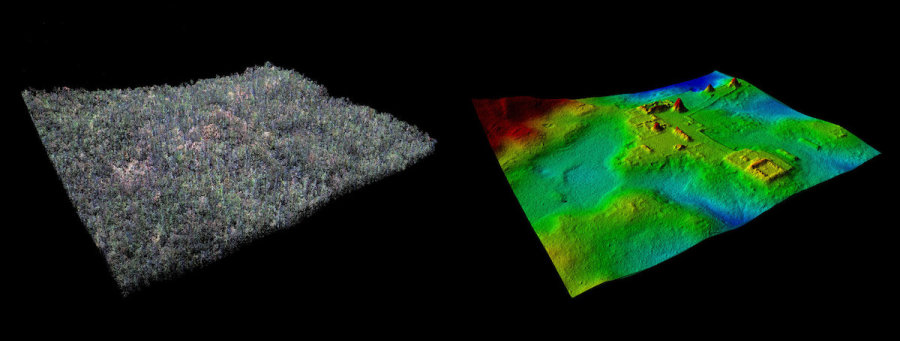The initiative follows teams that have studied other regions in Central America although much land area still remains. The Pacunam Lidar Initiativescientists representing institutions in the United States Guatemala Slovakia and Franceflew lidar surveys over 10 non-contiguous regions of northern Guatemala totaling 2144 km 2 in 2016.
 Guatemala S Maya Society Featured Huge Megalopolis Lidar Data Show
Guatemala S Maya Society Featured Huge Megalopolis Lidar Data Show
The findings from the LiDAR survey Houston said.

Pacunam lidar initiative. The ambitious project undertaken in 2016 was funded by Guatemalas Fundación PACUNAM. The current research is sponsored by the PACUNAM LiDAR Initiative which used revolutionary technology in 2018 to digitally remove the tree canopy from aerial images to reveal the vast ruins of a complex pre-Columbian civilisation more interconnected than. LiDAR technology is revealing remains of Tikal architecture which were literally hidden in plain sight.
The PACUNAM LiDAR Initiative PLI is a project that began in 2016 structured and funded by PACUNAM. And the recent survey is only the first phase of PACUNAMs LiDAR Initiative which seeks to map more than 5000 square miles of Guatemalas lowlands over the course of three years. Pacunam LiDAR Initiative Thomas Garrison Using Modern Technology to Uncover Tikal Architecture.
Lidar captures a digital census of forest volume and forest type Even within the scope of archaeology lidar data can be helpful beyond its initial use. The directors an international consortium of archaeologists and researchers include. De eerste fase van het LiDAR Initiative leverde de grootste dataset ooit op voor archeologisch onderzoek maar de medewerkers van het project en andere onderzoekers vragen nu al om meer.
The PACUNAM LIDAR INITIATIVE publishes largest lidar survey in the history of archaeology in Science Posted on October 4 2018 by Francisco Estrada-Belli The study the result of 2 years of intense analysis of 2100 km2 of lidar data by a team of international scholars with the coordination and support of Guatemalas Fundacion PACUNAM was published in the September 28. The Pacunam Lidar Initiative began two years ago bringing together a group of scholars and local authorities to undertake the largest-yet survey. The PLI data have made it possible to characterize ancient settlement and infrastructure over an extensive varied and representative swath of the central Maya Lowlands.
In 2016 the Pacunam Lidar Initiative PLI undertook the largest lidar survey to date of the Maya region mapping 2144 km2 of the Maya Biosphere Reserve in Guatemala. The survey is the first phase of the PACUNAM LiDAR Initiative a three-year project that will eventually map more than 5000 square miles 14000 square kilometers of. In de zomer gaat een tweede fase van gegevensverzameling van start vertelt Marianne Hernandez de directrice van PACUNAM.
Houston said the LiDAR initiative differed sharply from traditional fieldwork which has involved cutting through the jungle to allow access for cumbersome survey equipment. In February 2018 National Geographic broke the story of the PACUNAM LiDAR Initiative a sweeping aerial survey of some 800 square miles 2100 square kilometers of. LiDAR which stands for Light Detection and Ranging.
The same year Canuto and his colleagues were learning the true depths of Maya development in Guatemala archaeologist Takeshi Inomata from the University of Arizona was investigating a site in Mexico using lidar data freely available online. EL PETÉN GUATEMALASome 60000 Maya structures have been discovered in the dense forests of northern Guatemala by a consortium of scholars led by the PACUNAM LiDAR Initiative according to. In 2016 a privately funded lidar survey known as the Pacunam Lidar Initiative mapped 2144 km2 of forest in the remote Maya Biosphere Reserve of Guatemala.
Marcello A Canuto Tomás Barrientos Thomas Garrison Yeny Castillo Francisco Estrada-Belli Philippe Nondedeo Lilian Garrido Milan Kováč Sandra Ventura Mary Jane Acuña an Varinia. The PACUNAM LIDAR INITIATIVE publishes largest lidar survey in the history of archaeology in Science Posted on October 4 2018 by Francisco Estrada-Belli The study the result of 2 years of intense analysis of 2100 km2 of lidar data by a team of international scholars with the coordination and support of Guatemalas Fundacion PACUNAM was published in the September 28.